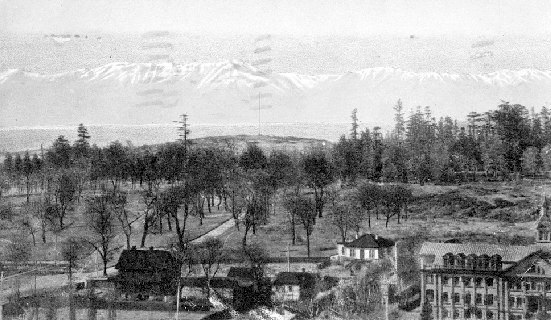St. Ann's Academy and the men and women who built it provide a microcosm of people's lives in British Columbia from the colonial period to Confederation with Canada (1871) and into the twentieth century. Fr.Joseph Michaud, John Teague, and Thomas Hooper came to Victoria (and left it) within strong forces of migration in nineteenth-century BC. These forces of migration enabled as well as confined each architect's participation in the construction of St. Ann's Academy, and they demonstrate how immediately important the social history of British Columbia was in the building of St. Ann's.1
Joseph Michaud came to BC in 1858 with the first Sisters of St. Ann from Canada East (Quebec) upon the request of
John Teague's life was a tiny picture of the ebb and flow of people and their fortunes in BC during and following the gold rushes. Teague came to BC from England via Canada and California in his search for gold. He, too, arrived in Victoria in 1858, but he was quickly off to the gold fields of the interior. After hardship in the gold fields, Teague finally settled in Victoria in 1860, and he started work in carpentry and architecture. Teague's failure as a miner actually led him to establish a business in Victoria, and nineteenth-century BC offered the opportunity for middle-class English nobodies to become colonial some-bodies.3 Teague became one of the most successful architects in BC, and he was elected mayor of Victoria, twice. The gold rush brought Teague to Victoria and colonial opportunity kept him there.
Teague's first wife came to British Columbia with an interesting gendered force to repopulate the wilderness with white women. Some colonists believed that white women would be a civilizing force in the colony and they advocated the shipment of young English women to BC. In 1863, Teague married Emily Birt Abington, who came to Victoria on one of the so-called brideships.4
Thomas Hooper was another Englishman, but he came to Victoria from Ontario with another unavoidable call Westward, the railroad. Hooper moved his architectural practice Winnipeg when it became obvious where the railroad was headed. He then pushed onwards to the Western terminus at Vancouver just in time for the Vancouver fire of 1886, and he helped rebuild the city. Hooper's social connections got him commissions in BC, and he quickly became a leading architect in both cities. Hooper was part of the immense project to connect Central Canada to its Westernmost province, which was a foreign country less than twenty years earlier for Fr. Joseph Michaud.
The lives of Michaud, Teague, and Hooper were clearly influenced by the larger patterns of West Coast migration, and St. Ann's was the product of British Columbia just as much as the product of the individuals who built it.
Footnotes
1 All the biographical information on this page is referenced on the biography pages for each architect.
2For an excellent examination of sojourners as temporary extensions of their original community see Robert Harney's examination of Italian migrants to Eastern Canada. Robert F. Harney, "Men Without Women: Italian Migrants in Canada, 1885-1930," A Nation of Immigrants: Women Workers and Communities in Canadian History 1840s-1960s, Franca Iacovetta et al. eds. (Toronto: University of Toronto Press, 1998), 208.
3 James [Jan] Morris, Pax Britannica: the Climax of an Empire, (London: Faber, 1968), 118-120.
4 See Adele Perry, On the Edge of Empire: Gender, Race, and the Making of British Columbia, 1849-1871 (Toronto: University of Toronto Press, 2001).
Photos:
BCA, "Beacon Hill Park and Olympic Range, Victoria, BC," 1907, B-03275.
